Effective Woodpecker Bird Repellent Solutions
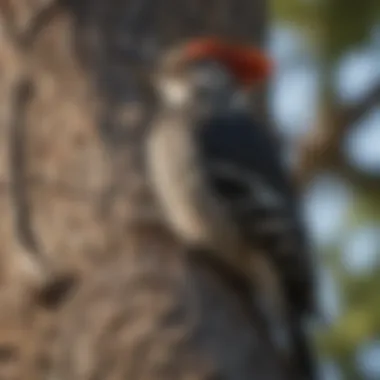
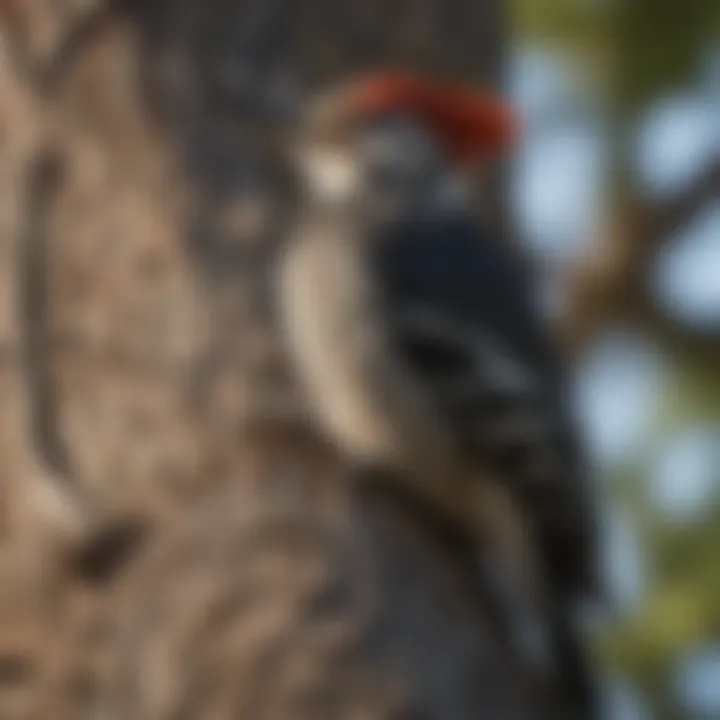
Intro
Woodpeckers can be a delight to observe, yet their presence can transform into a significant nuisance when they start damaging property. Understanding their behaviors and tendencies is critical for effective woodpecker management. This article aims to equip homeowners and pest management professionals with knowledge and tools to address woodpecker-related challenges. By exploring identification methods, effective repellent strategies, and ecological impacts, we hope to facilitate informed decisions in pest control and prevention.
Understanding Pests
Definition of Pests
Pests are organisms that negatively impact human activities, crops, or properties. In this context, woodpeckers are classified as pests due to their drilling habits, which can cause substantial damage to buildings, fences, and trees. Though these birds play a vital role in the ecosystem, their behavior can lead to conflict with humans. Their constant pecking can lead to unsightly holes and structural issues, especially in wooden structures.
Importance of Pest Identification
Identifying woodpeckers accurately is crucial for effective management. Different species exhibit varying behaviors, causing different levels of damage. For example, the Downy Woodpecker might not be as destructive as the Northern Flicker. Knowing which species you are dealing with can dictate the appropriate response and methods to mitigate their impact. This understanding lays the foundation for developing tailored repellents and preventive measures.
Prevention Techniques
Home and Garden Preventative Measures
Implementing preventative techniques can reduce the likelihood of woodpeckers causing damage.
- Visual Deterrents: Hang shiny objects, such as aluminum foil strips or reflective tape, near areas frequently targeted by woodpeckers. These create an unsettling environment for the birds.
- Sound Deterrents: Bird distress calls or other sounds can be effective in scaring woodpeckers away. Devices are available that can mimic sounds of predators or other alarming noises.
- Physical Barriers: Installing netting or mesh around vulnerable structures such as eaves and fences can prevent access to nesting sites.
Seasonal Prevention Tips
Taking note of seasonal changes can enhance preventative efforts.
- Spring: As woodpeckers begin their nesting routines, check your home's exterior for signs of potential vulnerability. Make repairs to any damaged areas.
- Summer: Maintain your garden by trimming trees and reducing food sources that may attract woodpeckers.
- Fall: Inspect for any autumn maintenance needs, sealing entry points to prevent nesting in winter.
- Winter: Focus on sound deterrents; woodpeckers may persist in their search for food during the colder months.
Eco-Friendly Pest Control Solutions
Overview of Sustainable Practices
Sustainability is essential when addressing woodpecker issues. Using eco-friendly strategies aligns both with homeowner values and the larger goal of environmental well-being.
- Planting Native Species: Promote the growth of indigenous plants around your property to create a more balanced ecosystem that discourages invasive woodpecker species.
- Encouraging Natural Predation: Attracting predators, like hawks, can deter woodpeckers, reducing the need for direct human intervention.
Natural Remedies and Their Effectiveness
Certain natural remedies hold promise in keeping woodpeckers at bay.
- Essential Oils: Oils such as peppermint or eucalyptus can repel birds when sprayed in and around entry points.
- Spices: Sprinkling cayenne pepper or other strong spices around targeted areas may create an unappealing environment for woodpeckers.
Employing natural remedies emphasizes a commitment to ecological balance while addressing woodpecker concerns.
Prelims to Woodpeckers
Understanding woodpeckers is essential for homeowners encountering issues with these birds. Woodpeckers are often perceived as pests, causing structural damage to properties, especially wooden surfaces. Their tapping can lead to significant repairs and emotional stress for the occupants. In this section, we will explore the behavior and species of woodpeckers, providing homeowners with the knowledge needed to implement effective solutions.
Understanding Woodpecker Behavior
Woodpeckers, scientifically known as Picidae, display fascinating behaviors. They are known for their drumming sound, which serves various purposes, including attracting mates and marking territory. Their strong beaks allow them to excavate wood, primarily to find insect larvae. This ability can be a boon for natural pest control but often results in damage to homes.
Woodpecker behavior is influenced by seasonal changes, particularly during mating and nesting seasons. During spring, they are particularly active, and their calls may be more frequent. Understanding these behaviors helps homeowners anticipate potential problems and act before costly damages occur.
Identifying Woodpecker Species
There are several species of woodpeckers, each differing in size, coloration, and behavior. Some common species include the Downy Woodpecker, Red-bellied Woodpecker, and the Pileated Woodpecker. Knowing which species is present in your area can guide your management decisions.
- Downy Woodpecker: Small and often found on feeders, characterized by a white belly and black wings.
- Red-bellied Woodpecker: Medium-sized with a distinctive red cap on the male, prefers deciduous forests and large trees.
- Pileated Woodpecker: Large, resembling a crow, known for its striking black and white markings and loud calls.
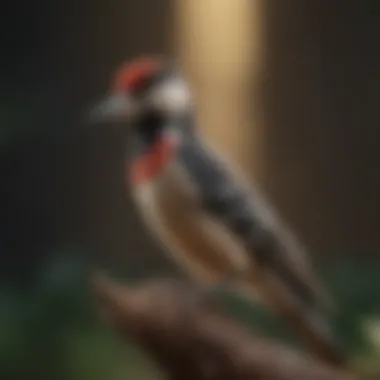
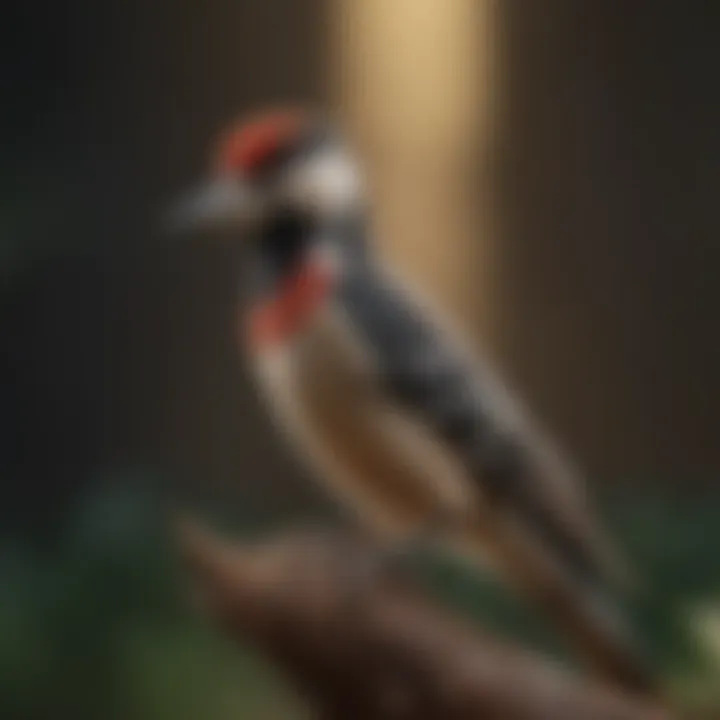
Recognizing these species and their unique habits allows homeowners to tailor their deterrent strategies effectively. By understanding their behaviors and preferences, one can create an environment that discourages their presence.
The Impact of Woodpeckers on Properties
Woodpeckers can often be a source of frustration for homeowners. Understanding the impact of woodpeckers on properties is essential when addressing woodpecker-related issues. These birds can cause significant damage to structures and landscaping. Recognizing the nature of this damage can lead to more effective management strategies.
Damage to properties mainly results from the woodpeckers' behavior. Woodpeckers peck at wood to find insects, create nesting sites, or communicate with other woodpeckers. Consequently, they can leave behind holes that compromise the integrity of wooden structures. Common areas affected include siding, fascia boards, and even shutters. Over time, the damage can escalate, leading to costly repairs.
In addition to physical damage, woodpeckers can also impact the aesthetic appearance of a home. Holes and markings in the siding can detract from property value. Homeowners may feel a decline in the attractiveness of their property, leading to further concern.
Common Damage Caused by Woodpeckers
There are several types of damage that woodpeckers can inflict:
- Holes in siding: These birds often create numerous holes in wooden siding. This can expose insulation and other materials to weather elements.
- Woodpecker holes in trees: Healthy trees may also suffer as woodpeckers bore into them, causing physical damage. This can weaken trees and make them susceptible to disease.
- Deep pecking marks: If left untreated, extended pecking can lead to significant structural issues. These can include rot and decay, resulting in a costly fix.
- Damage to roof and eaves: Woodpeckers may target areas such as eaves and roofs. Holes created here can also allow water intrusion, leading to further damage.
Addressing these issues quickly can save homeowners from extensive repairs and costs.
Factors Attracting Woodpeckers
Understanding what attracts woodpeckers is crucial in managing their presence. Several factors can bring these birds to residential areas:
- Food sources: Woodpeckers seek out insects like ants, beetles, and wood-boring insects. If these pests are abundant in the area, woodpeckers will find their way.
- Suitable nesting sites: Older, untreated wood can attract woodpeckers looking for nesting spaces. Properties with aging fences or siding are common targets.
- Environmental factors: Proximity to wooded areas or parks can lead to increased woodpecker sightings in neighborhoods. Natural habitats provide ideal food and shelter conditions.
By mitigating these attractions, homeowners can reduce the likelihood of woodpecker invasions. Awareness of woodpecker habits is an important step in effective pest management.
Repellent Strategies for Woodpeckers
Implementing effective repellent strategies for woodpeckers is essential for safeguarding properties from potential damage they can cause. The choice of strategy often hinges on understanding woodpecker behavior and identifying what makes a place attractive to these birds. While some methods are maintenance-free, others may require regular intervention. A combination of several repellent techniques tends to yield the best results, offering both immediate and long-term protection.
Visual Deterrents
Visual deterrents can be an influential component in woodpecker repellent strategies. By using elements that trigger a bird's innate fear or caution, homeowners can effectively discourage these birds from approaching their properties.
Reflective Materials
Reflective materials, such as aluminum foil or reflective tape, have gained popularity for their ability to confuse and deter woodpeckers. The primary characteristic of these materials is their ability to reflect sunlight, creating bright flashes that scatter in various directions. This unexpected burst of light can startle woodpeckers and prompt them to stay away from an area.
However, it's crucial to ensure that these reflective surfaces are placed correctly. They should be installed in locations where woodpeckers are likely to land or peck. The advantage of reflective materials lies in their low cost and ease of installation. However, they may lose effectiveness over time as birds may acclimatize to their presence.
Model Predators
Model predators, such as plastic owls or hawks, provide another layer of deterrent. These replicas exploit the natural fear of birds when they perceive a potential threat from other predatory birds. The key characteristic of model predators is their stationary nature, often appearing life-like enough to cause alarm.
Their main advantage is that they require very little maintenance. Homeowners can simply set them up and let them work. However, the effectiveness of model predators may diminish as woodpeckers become accustomed to their presence. Regularly moving these models or using different types may help sustain their deterrent effect.
Sound-Based Repellents
Sound-based repellents utilize audio cues to create an environment that is hostile or unwelcoming to woodpeckers. This approach relies on the sensory perception of the birds and can vary significantly in execution and effectiveness.
Ultrasonic Devices
Ultrasonic devices are designed to emit sounds that are beyond the audible range of the human ear but can be disturbing to woodpeckers. These devices work by broadcasting a constant series of high-frequency sounds that discourage woodpeckers from lingering.
The main advantage of ultrasonic devices lies in their passive nature; once installed, they work continuously without further input. Nevertheless, their effectiveness can vary based on the model and placement. Some users report limited results, suggesting that woodpeckers may habituate to the sounds over time.
Distressing Calls
Using the distress calls of woodpeckers or other birds can also serve as an effective repellent technique. By mimicking the sounds of a woodpecker in distress, this method aims to trigger an instinctual response to avoid the area. This approach is easy to implement using a variety of audio playback devices.
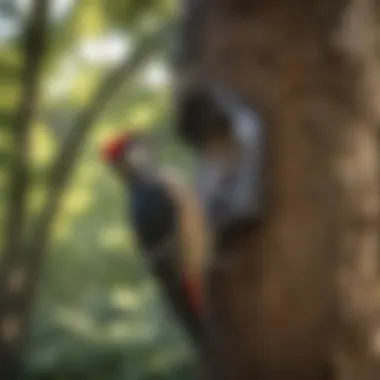
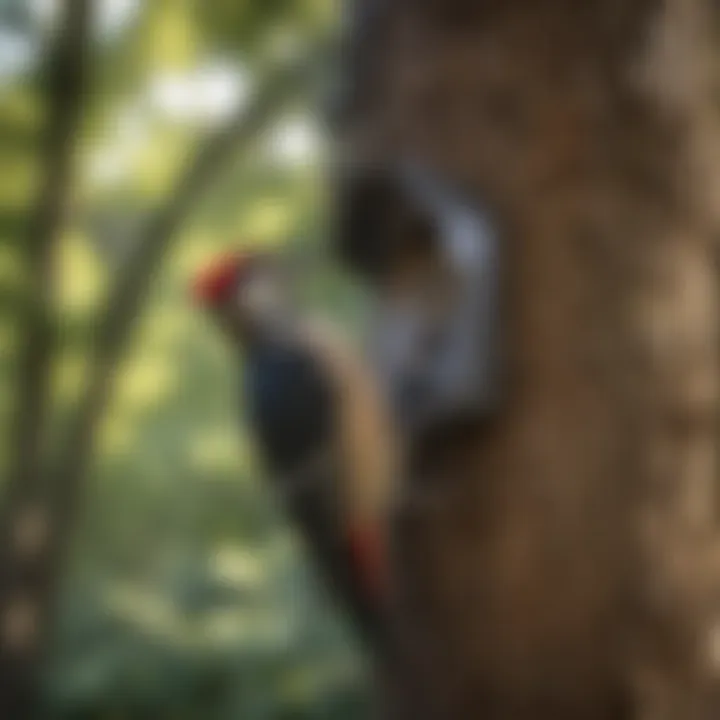
The unique aspect of distressing calls is their potential to be highly effective in the short term, as they replicate a natural alarm response among birds. However, similar to other sound-based strategies, their impact can wane if woodpeckers become accustomed to hearing the distress calls regularly.
Physical Barriers
Physical barriers are among the most direct and effective methods of preventing woodpecker damage. By blocking access to potential pecking sites, homeowners can significantly reduce the likelihood of woodpeckers causing harm.
Netting
Netting is a widely utilized method for creating physical barriers against woodpeckers. This fine mesh material can be installed over areas like wooden siding or houses that are frequently targeted. Its most significant characteristic is its ability to allow air and light to pass through while deterring birds.
The benefits of netting include its relatively low cost and ease of installation. It can provide long-lasting protection when properly secured. However, if not installed correctly, netting can sag or become loose, allowing woodpeckers access to the surface it is meant to protect.
Metal Flashing
Metal flashing involves placing metal strips over vulnerable areas of a structure. The primary characteristic of metal flashing is its durability and resistance to wear. This method not only protects against woodpeckers but also serves as a deterrent against other pests.
The unique value of metal flashing lies in its permanence and effectiveness in preventing pecking damage. That said, it may require a professional installation to ensure that the flashing is secure and aesthetically acceptable. Additionally, the initial investment can be higher compared to other options, yet it often pays off in the long run by providing lasting protection against woodpecker intrusions.
Natural and Eco-Friendly Repellent Options
Understanding natural and eco-friendly repellent options is crucial for those seeking effective ways to manage woodpecker intrusions without harming the local ecosystem. These methods not only provide humane solutions but also minimize environmental impact. Homeowners increasingly prefer biodegradable and non-toxic alternatives. This section explores two primary avenues: plant-based deterrents and habitat modifications. Both avenues aim to deter woodpeckers while promoting a balanced coexistence with nature.
Plant-Based Deterrents
Plant-based deterrents are one of the most effective natural strategies to keep woodpeckers at bay. These solutions often come from the use of specific plants known for their pungent smells or textures that are unpleasant to these birds.
For example, plants such as garlic and peppermint can act as deterrents. When their scents are used strategically, either by planting them in gardens or creating sprays, they may repel woodpeckers. It’s important to note that consistency in application is key. Regularly spraying a homemade mixture of these plants or keeping their extracts around can enhance effectiveness.
In addition to these methods, some homeowners consider using physical barriers made from prickly plants or thorny shrubs. These barriers can obstruct access to areas where woodpeckers tend to forage. This method not only serves as a deterrent but also contributes to the biodiversity of the garden.
Essentially, by using natural ingredients, homeowners create a more harmonious environment that does not involve any chemical substances or harmful interventions. However, while these approaches are eco-friendly, patience is required, as it may take time for woodpeckers to adjust to these natural changes.
Habitat Modifications
Creating habitat modifications is another vital strategy for reducing woodpecker attraction. This approach involves altering the existing environment around a property in ways that make it less inviting for woodpeckers.
One common practice is to remove or repair any damaged wood or siding on houses. Woodpeckers are especially drawn to decayed or damaged areas, as they provide easier access to insects residing within the wood. By improving the structural integrity, property owners can greatly reduce the likelihood of woodpeckers being lured in.
Another effective tactic is the installation of birdhouses or feeders meant for different bird species. By making your property appealing to other birds, you can potentially deter woodpeckers, as they typically prefer less competition from other avian species.
And lastly, keeping the surrounding area clean ensures that you eliminate any potential food sources that might attract woodpeckers. This includes clearing debris, such as fallen fruit and seeds, which can attract insects, the primary diet for woodpeckers.
Habitat modifications not only help in repelling woodpeckers but also create a healthier outdoor environment for various wildlife.
Behavioral Modification Techniques
The significance of behavioral modification techniques in the context of woodpecker management cannot be understated. These techniques aim to alter woodpecker behaviors that lead to property damage by changing their perceptions of the environment. Understanding their communication patterns and implementing specific strategies can help homeowners effectively deter them. This section focuses on the elements that influence these techniques and the benefits derived from their application.
Understanding Woodpecker Communication
Woodpecker communication is integral to their behavior and can aid in managing their presence. Woodpeckers have various calls and drumming patterns used for mating, territory establishment, and signaling alarm. By understanding these communicative aspects, homeowners can create environments that are less appealing to them.
Additionally, visual and auditory cues associated with threats can disrupt their natural behaviors. For instance, if a woodpecker recognizes a danger related to its drumming, it may opt to avoid certain areas. Homeowners can use this knowledge to introduce sounds or movements that mimic predators or create disturbances in areas frequented by woodpeckers. Effective communication deterrents can significantly reduce the likelihood of damage caused by these birds.
Exclusion Tactics During Nesting Season
Exclusion tactics are particularly crucial during the nesting season when woodpecker activity peaks. During this time, woodpeckers are focused on building nests and raising young. This makes them more prone to exploit any potential nesting sites, often leading to significant property damage.
To counter this, homeowners should consider the following tactics:
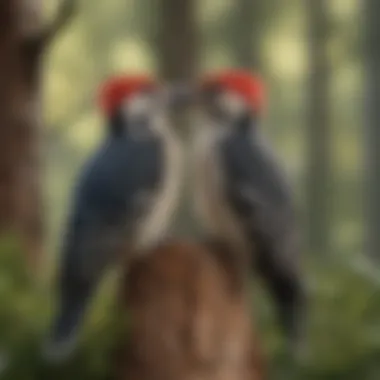
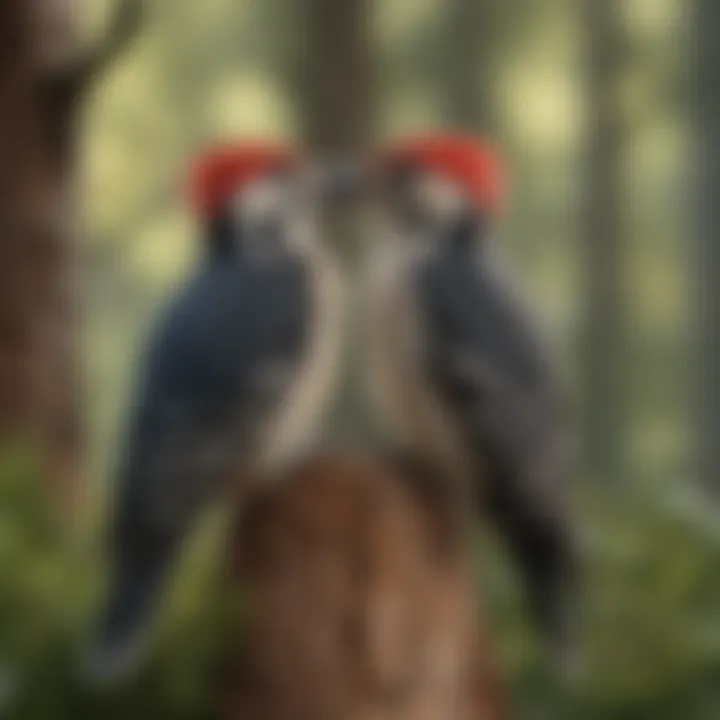
- Inspect your property for signs of woodpecker activity, especially during early spring.
- Seal any crevices or gaps in walls or eaves that may serve as nesting sites.
- Use protective materials like netting or metal barriers on vulnerable surfaces to prevent access.
Implementing these exclusion tactics can effectively reduce woodpecker nesting in undesirable areas. Moreover, it is important to act before the nesting season begins. Once woodpeckers have established nests, many local wildlife protection laws may restrict actions that can be taken against them, making early intervention critical.
"Understanding and modifying woodpecker behavior can lead to more successful management strategies while promoting coexistence with these birds."
Legal and Ethical Considerations
Considerations around the legal and ethical management of woodpeckers are vital for homeowners dealing with these birds. Understanding wildlife protection laws, as well as focusing on ethical repellent practices, ensures that any actions taken while managing woodpecker problems remain both responsible and compliant with regulations.
Woodpeckers, like many birds, are protected under various environmental laws. These laws are enforced to preserve the natural ecosystem and ensure that wildlife populations remain stable and viable. Ignoring these legal stipulations can result in heavy fines or other penalties. Therefore, it is crucial for homeowners to be informed and stay on the right side of the law when addressing woodpecker issues.
Understanding Wildlife Protection Laws
In various regions, woodpeckers may be classified under specific wildlife protection laws. The Migratory Bird Treaty Act in the United States protects many species of birds from being captured, hunted, or disturbed during their nesting phases. It is essential to recognize which species of woodpecker you are dealing with, as different species may have different degrees of protection. This understanding allows homeowners to assess their legal obligations realistically.
Homeowners should also consult local regulations, as some states or municipalities may have additional laws concerning wildlife. Making inquiries to local wildlife agencies can clarify what actions are permissible. Information can often be found on their official websites or through direct communication. Knowing how the law serves to protect these birds helps cultivate responsible practices around property maintenance.
Ethical Repellent Practices
Opting for ethical repellent practices is more than just a good idea; it establishes a commitment to wildlife welfare. Using humane methods to deter woodpeckers respects their role in the ecosystem. Many effective repellent strategies exist that do not harm the birds but instead create an environment where they are less inclined to damage property.
For example, incorporating visual deterrents can effectively manage woodpecker issues without causing harm. Reflective materials can be hung around the areas of concern. These materials disorient birds, yet they do not pose a danger.
On the other hand, ethical considerations include avoiding any practices that may involve poisoning or harming the birds. Such actions are not only illegal in many places, but they can also disrupt local ecosystems by affecting the food chain.
"Engaging in ethical repellent practices allows homeowners to manage their property effectively while respecting the rights of wildlife."
When seeking professional help, homeowners should ensure that pest management services adhere to ethical standards in wildlife control. Always inquire about the methods they use. Effective management of woodpecker-related problems can be achieved without compromising the legal and ethical standards that protect these birds.
Professional Woodpecker Management Services
Dealing with woodpecker-related issues can be complex and sometimes overwhelming for homeowners. This is where the significance of enlisting professional woodpecker management services comes into play. The professionals are equipped with specialized knowledge and experience that most homeowners may lack. They provide not only effective solutions but also educate clients on how to prevent future woodpecker invasions.
Professional services can effectively assess the extent of woodpecker damage and recommend targeted strategies that might not be accessible or feasible for an untrained individual. Furthermore, they possess the necessary tools and resources to implement such strategies efficiently. Choosing to seek professional help may save homeowners time and financial resources in the long run by addressing the problem properly from the outset.
When to Seek Professional Help
There are specific situations where it becomes essential to seek professional assistance regarding woodpecker management. For one, if woodpeckers are causing substantial damage to your home or property, the immediacy of the issue should prompt a call to experts. Similar urgency should be considered if these birds have made a nest in an unsuitable area, raising potential safety and legal issues.
Additionally, if you have tried various DIY solutions without success, it may be time to involve professionals. They can provide advanced techniques that are more effective than common remedies. Lastly, if woodpeckers seem to return year after year despite your efforts, professional intervention is advisable to address the root problem.
Choosing a Qualified Pest Management Provider
Selecting a qualified pest management provider is crucial for the efficacy of your woodpecker control strategies. Begin by looking for certification and licensing to ensure that the provider meets industry standards. A company that is part of recognized professional organizations will likely adhere to ethical practices and employ knowledgeable specialists.
Next, review user feedback and testimonies about their service. This can provide you clarity on how well they have performed in past projects. An effective pest control provider will offer a thorough inspection before proposing a solution, ensuring that their approach is customized to your unique situation.
Additionally, inquire about their methods and equipment. Providers utilizing humane and environmentally safe practices should be prioritized. Getting a clear understanding of your investment and the expected outcomes is crucial. In the end, a thoughtful selection process will enhance the chances of effective woodpecker management and a harmonious environment.
Ending: Strategies for Successful Woodpecker Management
In the journey to manage woodpecker-related issues, it is crucial to synthesize the knowledge acquired from previous sections. Successful woodpecker management entails a multifaceted approach that combines understanding, prevention, and intervention strategies. This endeavor not only protects properties from potential damage but also fosters a responsible coexistence with wildlife.
Firstly, a key element in effective woodpecker management is recognizing the signs of their presence and understanding their behavior. This foundational information allows homeowners to anticipate when these birds might be a problem. For instance, woodpeckers are generally active during certain seasons, making it essential to monitor their activities closely.
Implementing diverse repellent strategies is also vital. Homeowners have a variety of options to choose from, which can be tailored to their specific circumstances. Visual deterrents like reflective materials or models of predators can startle woodpeckers, while sound-based repellents using ultrasonic devices can disrupt their communication. Physical barriers such as netting provide a more permanent solution and keep woodpeckers away from vulnerable areas.
Moreover, it is wise to consider natural and eco-friendly options. Modifying habitats by reducing food sources and altering nesting sites can significantly deter woodpeckers without compromising ecological integrity.
In addition to implementing these strategies, seeking professional assistance can be beneficial. There are times when individuals may find it challenging to manage woodpecker issues on their own. Knowing when to engage pest management professionals ensures that the leafing through options is thorough and informed.
Lastly, adhering to legal and ethical guidelines cannot be overstated. The importance of preserving wildlife while managing pest issues is fundamental. Understanding wildlife protection laws can safeguard homeowners from unintentionally violating regulations, which can lead to fines or other penalties.
By embracing these principles, homeowners can cultivate an effective and sustainable approach to woodpecker challenges, balancing their needs with the natural environment.



